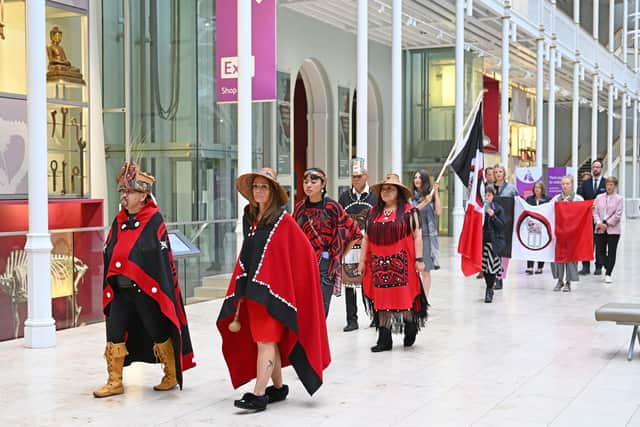Scotland agrees to return totem pole ‘stolen’ from First Nation village in Canada after nearly a century on display in Edinburgh
and live on Freeview channel 276
Bosses running Scotland’s busiest visitor attraction have agreed to the move after hosting talks on the artefact with a delegation of Nisga’a Nation leaders.
The House of Ni'isjoohl Memorial Pole, which has been on display in the National Museum of Scotland (NMS) in Edinburgh since 1930, tells the story of Ts’wawit – a warrior who was next in line to be chief before being killed in a conflict with a neighbouring nation.
Advertisement
Hide AdAdvertisement
Hide AdIt will become only the second totem pole to be repatriated from a European museum to Canada after National Museums Scotland, which runs the attraction, and the Scottish Government agreed to a formal request.


The House of Ni’isjoohl is one of about 50 houses within the Nisga’a Nation, the original occupants of the Nass River Valley of north-western British Columbia. Dating back to 1855, the memorial pole was carved from red cedar by artist Oyea Tait and his assistant carver Gwanes.
Depicting a series of interlocking figures relating to Ts’aawit's family history through his ancestors, family crests, and his clan, it originally stood in front of the house of Ts’aawit's relatives in Ank’idaa village on the Nass River.
When the Nisga’a Nation delegation visited Edinburgh in August, it was claimed the memorial pole had been “stolen” by ethnographer and anthropologist Marius Barbeau, a curator at the National Museum of Canada, in 1929.
Advertisement
Hide AdAdvertisement
Hide AdA spokesman for the Nisga’a Nation said at the time: “The pole was taken without the consent of the House of Ni’isjoohl, during a period when the Nisga’a Peoples were away from their villages for the annual hunting, fishing, and food harvesting season.”


NMS’s announcement on the return of the memorial pole insists that Barbeau purchased it from its Nisga’a owners on behalf of the then Royal Museum of Scotland.
However NMS director Dr Chris Breward said: “We’re committed to promoting understanding and dialogue with respect to those parts of our collection associated with our nation’s colonial history and its difficult legacies.
"We’re pleased to have reached this agreement and to be able to transfer the memorial pole to its people and to the place where its spiritual significance is most keenly understood.”
Advertisement
Hide AdAdvertisement
Hide AdSim'oogit Ni'ijoohl (Chief Earl Stephens) of the Nisga’a Nation said: "In Nisga’a culture, we believe this pole is alive with the spirit of our ancestor. After nearly 100 years, we’re finally able to bring our dear relative home to rest on Nisga’a lands.


"In means so much for us to have the pole returned to us, so we can connect our family, nation and our future generations with our living history."
Culture secretary Angus Robertson said: “I welcome the decision to return the memorial pole to its place of origin. It follows a deeply moving recent meeting with the Nisga’a delegation when they came to Scotland to explain the huge importance of the pole to their culture, people and community.
“I would like to thank the board for their speedy, but careful consideration of the request and for reaching such a positive outcome and also the Nisga’a delegation for helping us to understand the memorial pole’s history and importance to them.”
Comment Guidelines
National World encourages reader discussion on our stories. User feedback, insights and back-and-forth exchanges add a rich layer of context to reporting. Please review our Community Guidelines before commenting.
